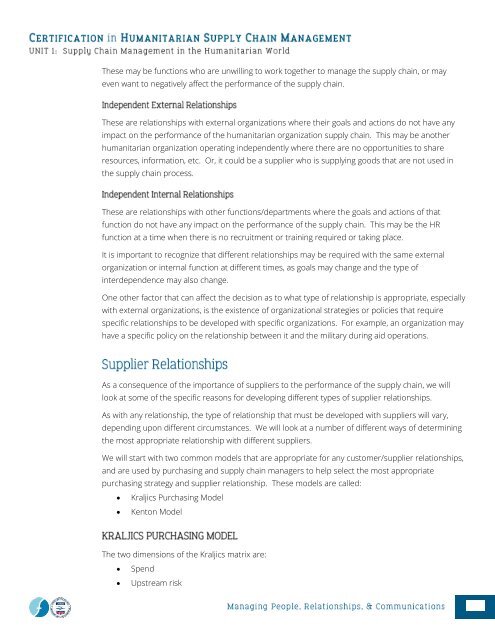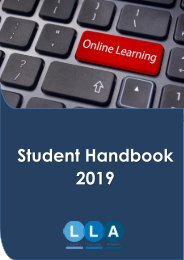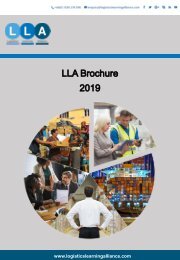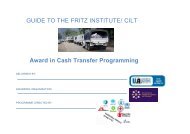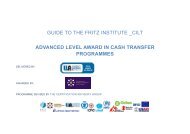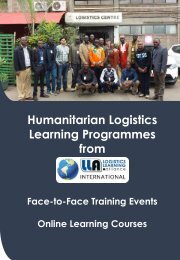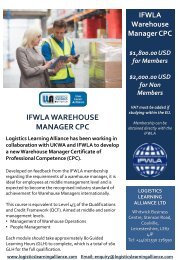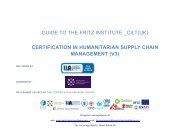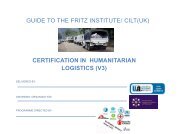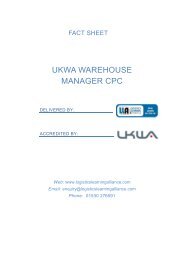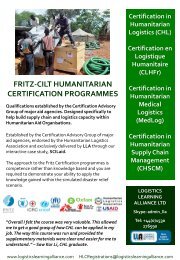CHSCM 3.0 - Unit 1 - SCM in the Humanitarian World
Learning Materials for Unit 1 of the Certification in Humanitarian Supply Chain Management (CHSCM).
Learning Materials for Unit 1 of the Certification in Humanitarian Supply Chain Management (CHSCM).
You also want an ePaper? Increase the reach of your titles
YUMPU automatically turns print PDFs into web optimized ePapers that Google loves.
These may be functions who are unwill<strong>in</strong>g to work toge<strong>the</strong>r to manage <strong>the</strong> supply cha<strong>in</strong>, or may<br />
even want to negatively affect <strong>the</strong> performance of <strong>the</strong> supply cha<strong>in</strong>.<br />
These are relationships with external organizations where <strong>the</strong>ir goals and actions do not have any<br />
impact on <strong>the</strong> performance of <strong>the</strong> humanitarian organization supply cha<strong>in</strong>. This may be ano<strong>the</strong>r<br />
humanitarian organization operat<strong>in</strong>g <strong>in</strong>dependently where <strong>the</strong>re are no opportunities to share<br />
resources, <strong>in</strong>formation, etc. Or, it could be a supplier who is supply<strong>in</strong>g goods that are not used <strong>in</strong><br />
<strong>the</strong> supply cha<strong>in</strong> process.<br />
These are relationships with o<strong>the</strong>r functions/departments where <strong>the</strong> goals and actions of that<br />
function do not have any impact on <strong>the</strong> performance of <strong>the</strong> supply cha<strong>in</strong>. This may be <strong>the</strong> HR<br />
function at a time when <strong>the</strong>re is no recruitment or tra<strong>in</strong><strong>in</strong>g required or tak<strong>in</strong>g place.<br />
It is important to recognize that different relationships may be required with <strong>the</strong> same external<br />
organization or <strong>in</strong>ternal function at different times, as goals may change and <strong>the</strong> type of<br />
<strong>in</strong>terdependence may also change.<br />
One o<strong>the</strong>r factor that can affect <strong>the</strong> decision as to what type of relationship is appropriate, especially<br />
with external organizations, is <strong>the</strong> existence of organizational strategies or policies that require<br />
specific relationships to be developed with specific organizations. For example, an organization may<br />
have a specific policy on <strong>the</strong> relationship between it and <strong>the</strong> military dur<strong>in</strong>g aid operations.<br />
As a consequence of <strong>the</strong> importance of suppliers to <strong>the</strong> performance of <strong>the</strong> supply cha<strong>in</strong>, we will<br />
look at some of <strong>the</strong> specific reasons for develop<strong>in</strong>g different types of supplier relationships.<br />
As with any relationship, <strong>the</strong> type of relationship that must be developed with suppliers will vary,<br />
depend<strong>in</strong>g upon different circumstances. We will look at a number of different ways of determ<strong>in</strong><strong>in</strong>g<br />
<strong>the</strong> most appropriate relationship with different suppliers.<br />
We will start with two common models that are appropriate for any customer/supplier relationships,<br />
and are used by purchas<strong>in</strong>g and supply cha<strong>in</strong> managers to help select <strong>the</strong> most appropriate<br />
purchas<strong>in</strong>g strategy and supplier relationship. These models are called:<br />
• Kraljics Purchas<strong>in</strong>g Model<br />
• Kenton Model<br />
The two dimensions of <strong>the</strong> Kraljics matrix are:<br />
• Spend<br />
• Upstream risk


